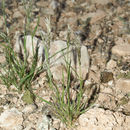en
names in breadcrumbs


Agdaegras (Enneapogon desvauxii P.Beauv.) is 'n grasspesie wat inheems is aan Suid-Afrika, Botswana en Namibië. Dit kom veral in die Nama-Karoo en die Kalahari voor. Op die SANBI-rooilys is dit as 'veilig' (LC) gelys.[1]
Die naam het betrekking op die vinnige groei van die plant ná reënval. Dit kan agt dae later reeds bewei word. Die beweidingswaarde is nogtans gering.
EIW SWIW LnregWIW Weidingsindekswaarde[2] 1 1 0.9Agdaegras (Enneapogon desvauxii P.Beauv.) is 'n grasspesie wat inheems is aan Suid-Afrika, Botswana en Namibië. Dit kom veral in die Nama-Karoo en die Kalahari voor. Op die SANBI-rooilys is dit as 'veilig' (LC) gelys.
Умардын оготны сүүл - (англ. Pappophorum boreale), (орос. Хохлатник северный)
5-25 см өндөр нэг наст ургамал. Хотойж зүү мэт нарийссан ноорслог иш, зөөлөн навчтай, 1-4 см урт хөтөвтөр саарал өнгийн гонзгой түрүү баг цэцэгтэй. Түрүүхэйнд хоёр цэцэг байдгийн нэг нь гүйцэд хөгжөөгүй, хайрс нь 5 судалтай. Өвөл сайн хагдарч хадгалагдана. Гантай үед тун намхан (4-6см) ургах боловч толгойлж үрлэдэг.
Цөлийн бүсийн районы чулуурхаг цөл, цөлөрхөг хээрийн уулын хажуу голын сав, элс хайрга бүхий газар ургана.[1]

Умардын оготны сүүл - (англ. Pappophorum boreale), (орос. Хохлатник северный)
5-25 см өндөр нэг наст ургамал. Хотойж зүү мэт нарийссан ноорслог иш, зөөлөн навчтай, 1-4 см урт хөтөвтөр саарал өнгийн гонзгой түрүү баг цэцэгтэй. Түрүүхэйнд хоёр цэцэг байдгийн нэг нь гүйцэд хөгжөөгүй, хайрс нь 5 судалтай. Өвөл сайн хагдарч хадгалагдана. Гантай үед тун намхан (4-6см) ургах боловч толгойлж үрлэдэг.
Цөлийн бүсийн районы чулуурхаг цөл, цөлөрхөг хээрийн уулын хажуу голын сав, элс хайрга бүхий газар ургана.
Enneapogon desvauxii is a species of grass known by the common name nineawn pappusgrass. This is a short perennial bunchgrass native to the southwestern United States, northern Mexico, parts of South America, and occurs throughout arid parts of Africa.[1] It is known less often on other continents.
Enneapogon desvauxi grows erect stems 10 to 40 centimeters tall.
It has a few hairy, thready leaves and fluffy gray inflorescences. Each spike is 3 to 6 centimeters long and contains fertile florets which form the fruit grain, each with nine spreading awns with white hairs.
Enneapogon desvauxii is a species of grass known by the common name nineawn pappusgrass. This is a short perennial bunchgrass native to the southwestern United States, northern Mexico, parts of South America, and occurs throughout arid parts of Africa. It is known less often on other continents.
Pikkuhahtupää (Enneapogon desvauxii) on heinäkasvien (Poaceae) heimoon, hahtupäiden (Enneapogon) sukuun kuuluva monivuotinen kasvilaji. Se on kasvutavaltaan tiiviisti mätästävä ja kasvaa 5–35 cm korkeaksi. Sen lehtilavat ovat 2–12 cm pitkiä ja 1–3 mm leveitä. Pikkuhahtupään kukinto on harmaa ja tiivis, tähkää muistuttava röyhy. Tähkylät ovat 5,5–7 mm pitkiä ja kolmikukkaisia. Tähkylöiden kaleissa on kolmesta yhdeksään suonta. Ulkokaleet ovat 3–3,5 mm pitkiä ja sisäkaleet 4–5 mm pitkiä. Ulkohelpeet ovat 1,5–2 mm pitkiä sekä tiheäkarvaisia. Vihneet ovat 2–4 mm pitkiä. Pikkuhahtupää on sukunsa ainoa laji, joka lisääntyy itsepölytyksen kautta kleistogamisesti.[1]
Pikkuhahtupää kasvaa kuivilla vuorenrinteillä 1000–1900 metrin korkeudella merenpinnan yläpuolella. Pikkuhahtupää on sukunsa laajimmalle levinnyt laji ja sitä tavataan Aasiassa, Afrikassa sekä Amerikoissa.[1]
Pikkuhahtupää (Enneapogon desvauxii) on heinäkasvien (Poaceae) heimoon, hahtupäiden (Enneapogon) sukuun kuuluva monivuotinen kasvilaji. Se on kasvutavaltaan tiiviisti mätästävä ja kasvaa 5–35 cm korkeaksi. Sen lehtilavat ovat 2–12 cm pitkiä ja 1–3 mm leveitä. Pikkuhahtupään kukinto on harmaa ja tiivis, tähkää muistuttava röyhy. Tähkylät ovat 5,5–7 mm pitkiä ja kolmikukkaisia. Tähkylöiden kaleissa on kolmesta yhdeksään suonta. Ulkokaleet ovat 3–3,5 mm pitkiä ja sisäkaleet 4–5 mm pitkiä. Ulkohelpeet ovat 1,5–2 mm pitkiä sekä tiheäkarvaisia. Vihneet ovat 2–4 mm pitkiä. Pikkuhahtupää on sukunsa ainoa laji, joka lisääntyy itsepölytyksen kautta kleistogamisesti.
Pikkuhahtupää kasvaa kuivilla vuorenrinteillä 1000–1900 metrin korkeudella merenpinnan yläpuolella. Pikkuhahtupää on sukunsa laajimmalle levinnyt laji ja sitä tavataan Aasiassa, Afrikassa sekä Amerikoissa.
Enneapogon desvauxii là một loài thực vật có hoa trong họ Hòa thảo. Loài này được P.Beauv. mô tả khoa học đầu tiên năm 1812.[1]
Enneapogon desvauxii là một loài thực vật có hoa trong họ Hòa thảo. Loài này được P.Beauv. mô tả khoa học đầu tiên năm 1812.